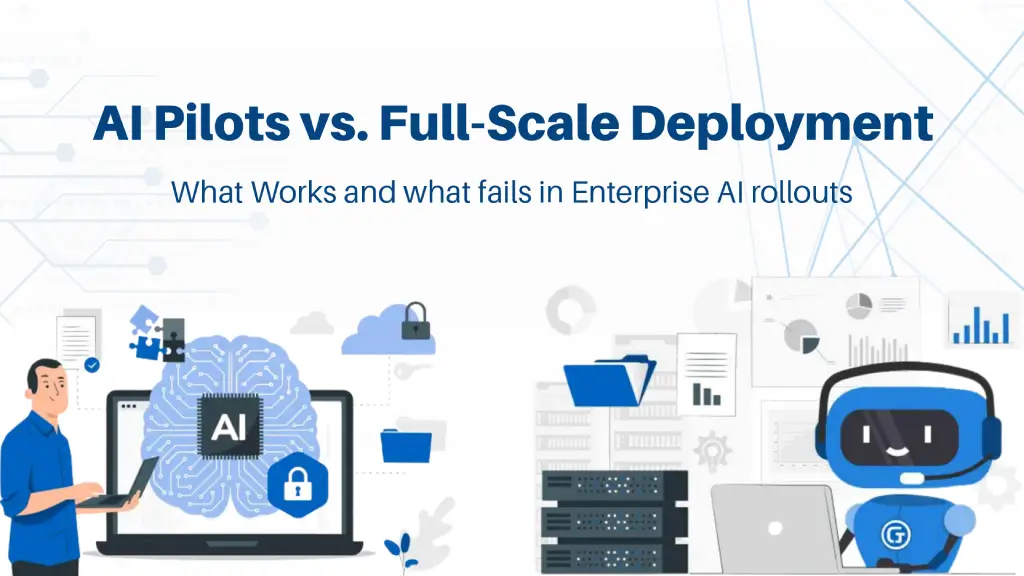Loading content...
- Software DevelopmentIT Consulting & DesignAI & Data SolutionsQuality AssuranceTeam & Resource SupportBusiness Support Services
AI pilots are low-risk, high-learning experiments—but scaling is where the real impact (and risk) lies. This guide explores when and how to move beyond pilot mode and drive lasting value with full-scale AI deployment.
Most firms start with pilots to test AI ROI before committing at scale.
Scaled AI deployments yield greater business returns—but add complexity.
Scaling without preparation increases data, ops, and change management risk.
Loading content...
Let's discuss your project and create a custom web application that drives your business forward. Get started with a free consultation today.

Think about this: It's 9 a.m. at a medium-sized business. Recently, the leadership team concluded a six-week AI pilot project, which aimed to automate invoice processing. What were the results? Looks excellent. The increased accuracy and reduced turnaround time instilled cautious optimism among the employees. But as everyone exits the conference room, a question that everyone knows comes up: Should we use this AI solution across the whole company, or was the pilot just a honeymoon phase?
You know the moment is a crossroads if you're in charge of digital transformation. Gartner says that more than 80% of businesses tried out AI in 2023, but just 53% moved on to use it more widely. Why? Pilots are safe places to play with AI; full-scale AI is where the real testing happens. This article delves into the issue of AI pilots versus full-scale deployment, examining concrete facts, potential business risks, and proven strategies. You'll learn what works and what doesn't through real-life examples and expert advice, whether you're new or ready to grow.
AI pilots give businesses a chance to try out new technologies, see if they work, and get rapid wins without having to make big changes or spend a lot of money.
For example, a Forrester survey from 2024 revealed that 70% of businesses would rather start with pilots to see how AI affects their business before spending a lot of money on it. For example, a retail chain could use AI to guess how many people would come to a store in a certain area. If it works, the team makes a case for expanding the use of AI.
Moltech has helped scores of firms start AI pilots with no risk, which lets you check the ROI before going all in.
The biggest benefits of AI for business come after it has been scaled up, but so do the biggest problems. Full-scale deployments put teams under a lot of stress when it comes to managing change, integrating systems, and running things in real time.
McKinsey says that organizations that scaled AI solutions experienced returns on investment (ROI) that were up to 20% greater than those that were still in the pilot stage. However, they also had 40% more integration problems and project delays. Think about how much more complicated it would be to automate customer service for thousands of agents.
Moltech's end-to-end AI implementation strategy directly solves these issues, making sure that your AI is not only new but also has a big effect.
Many pilots stall or fail to grow because the data isn't good enough, the business goals aren't clear, and there isn't enough support from executives.
A worldwide bank launched a successful test program to find fraud, but it couldn't roll out the program to all of its branches since the data pipelines weren't connected throughout the whole company. Because of this, silos stayed in place, and the efforts to find fraud fell behind.
We help you avoid the "pilot graveyard" by giving you clear roadmaps and making sure everyone is on the same page.
Success depends on strong data foundations, robust governance, and an agile approach to change.
Gartner recommends that firms standardize data pipelines, implement continuous monitoring, and bake in change management early. For example, a healthcare provider scaled a predictive AI for patient risk by prioritizing data quality and staff training from day one—reducing hospital readmissions by 15%.
Here's how a Python-based AI workflow might move from pilot to production, with monitoring added:
Do you need help designing scalable data pipelines or monitoring models? Moltech's data engineers can help you future-proof your AI initiatives.
1
2
3
4
5
6
7
8
9
10
# Pilot stage: simple workflow
def predict(input_data):
return ai_model.predict(input_data)
# Production: robust workflow with logging and monitoring
def predict_with_monitoring(input_data):
prediction = ai_model.predict(input_data)
log_event("prediction", input_data, prediction)
monitor_performance(prediction)
return predictionThere's no universal timeline—but key signals include strong pilot ROI, executive buy-in, and operational readiness.
A logistics firm knew it was time to scale when its warehouse-picking AI pilot delivered a 30% speed boost and floor staff started requesting it for other locations. According to IDC, organizations that "wait too long to scale" risk being leapfrogged by more agile competitors.
Moltech's AI strategy workshops assist in assessing readiness and charting the ideal route from pilot to enterprise-wide transformation.
AI pilots are a safe and necessary method to try things out, but real change happens on a large scale. The jump from pilot to production adds more value and additional problems that need to be solved. We're coming up with new ways to handle people, data, and processes. You're not the only one who feels trapped at the pilot stage or wants to be sure your full-scale rollout works.
Set up a free strategy session with one of Moltech's AI specialists, or download our "Scaling AI for Real Business Impact" guide for ideas you can apply right away.
Let's connect and discuss your project. We're here to help bring your vision to life!
Complexity in integration and managing change, particularly in legacy systems, pose significant risks.
Track business KPIs (ROI, efficiency), user adoption, and technical performance.
Typically, the duration of an AI pilot ranges from 3 to 6 months, but it's crucial to concentrate on the achievement of specific goals rather than the timetable.